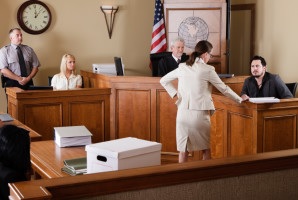OK- I am pulling a bit of the ol’ switcheroo here. I know you were probably expecting this installment of my series on trial organization to focus on the trial binder. Relax, that’s coming. I changed topics at the last minute because I recently saw two blog posts that touch on another trial organization issue that I was planning to talk about anyway- using PowerPoint or other multimedia presentations at trial.
The legal field tends to lag far behind the business world in its use of technology. But our jurors live in the modern world. They are accustomed to most presentations being accompanied by digital media or video, and they expect this from trial presentations as well. They expect the technology to work right and they expect us to know how to use it.
 I often use PowerPoint at trial. It’s more visually impressive than a foam-board blow-up, and I like being able to use the remote to click on images as I speak. I also use video a lot because often it is the only realistic way to present expert medical testimony. Many doctors are unwilling to close down their practice for an afternoon to appear live at trial, and for many cases, the fee they would charge to come live is outside the budget for the case. This leaves only Plan B, which is a de bene esse video deposition to be played at trial.
I often use PowerPoint at trial. It’s more visually impressive than a foam-board blow-up, and I like being able to use the remote to click on images as I speak. I also use video a lot because often it is the only realistic way to present expert medical testimony. Many doctors are unwilling to close down their practice for an afternoon to appear live at trial, and for many cases, the fee they would charge to come live is outside the budget for the case. This leaves only Plan B, which is a de bene esse video deposition to be played at trial.
Using either PowerPoint or video at trial poses the same set of organizational challenges. They can be powerful persuasive tools if they are used the right way, and they are used properly. Some studies indicate that jurors only pay close attention for about 4 minutes, and even then they are focusing on visuals and body language more than anything. You don’t want all the jury remembers from that 4 minutes to be you fumbling around, frantically trying to get your equipment to work. Professional jury consultant Alexandra Rudolph agrees that when trial technology doesn’t work, it makes the lawyer look like an amateur and puts the jury’s attention on the attorney instead of the evidence. I don’t think I needed a jury consultant to tell me that, but she’s right. Keeping organized minimizes the risk of this happening. So here are my tips for using multimedia technology at trial, some of which I have learned from painful experience.
The first important element to using technology at trial is the equipment itself. Many courts offer access to audiovisual equipment, or it can be reserved through the local bar association (sometimes for a fee). I never use somebody else’s equipment. This is because I don’t have experience using it, I don’t know if it works right, and I would probably have trouble using it seamlessly. Trials are hard enough without learning new equipment on the fly. Instead, I always bring my own equipment.
What to Take to a Trial?
Physically, this is what I bring to court:
•My laptop
•A 10 foot HDMI cable. This gives you some flexibility on where the laptop is in relation to the screen.
•A 36-inch HD flatscreen monitor with remote control. We have a portable one with its own carrying case for easy transport. Replace this with a projector and screen for longer, more complex, trials.
•A 10 foot, 3 pronged extension cord with multiple outlets. There’s not always going to be an outlet in the courtroom where you want to set the equipment up.
•A remote “clicker” that plugs into the laptop’s USB port, with spare batteries. This allows you to move from slide to slide as you talk, without requiring another person to help. Mine also has a built-in laser pointer, if that’s your thing.
Because this is my equipment and I use it all the time, I can set it up in less than five minutes without fumbling around. For opening or closing, I usually sit the video monitor on a table a few feet in front of the jury box. That lets me move around as I speak, and I can see the screen as I use the remote to move through slides. I do the same thing when I will play a video deposition, except I make sure the laptop is behind the monitor with the screen facing the trial tables. That way the lawyers and the parties can follow the testimony without moving to a different location in the courtroom.
Having the right equipment organized and ready is only half the battle, though. Next up: preparing yourself to use it at trial.
 Baltimore Injury Lawyer Blog
Baltimore Injury Lawyer Blog

